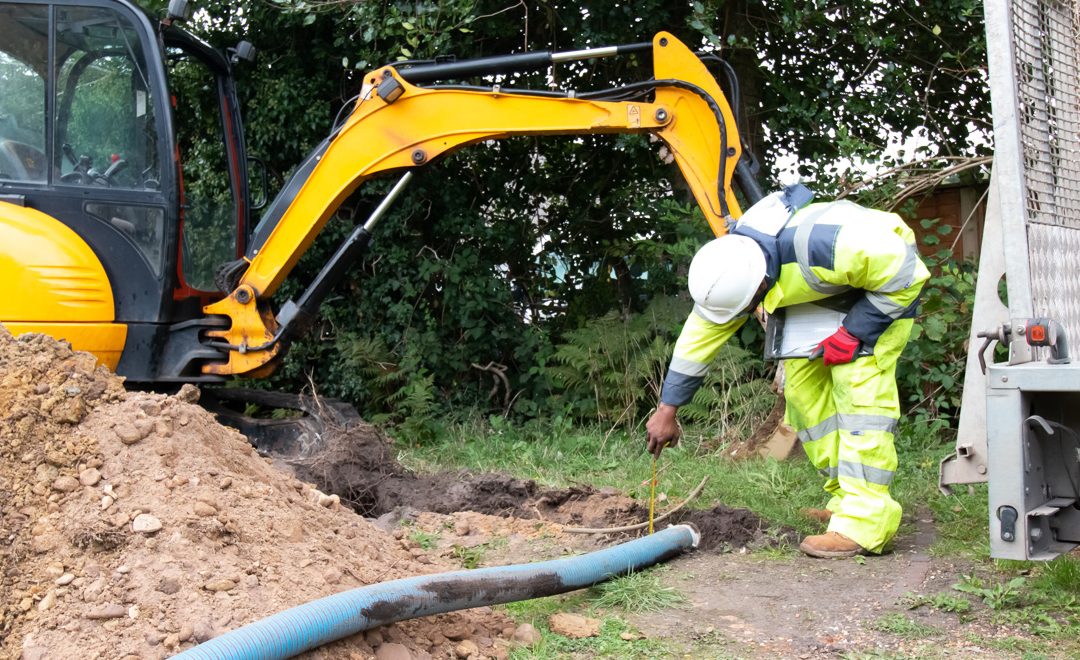The G&W Guide to… Soakaway Testing
Geoenvironmental • Geotechnical • Industry matters
How to manage the water that collects on the roofs and roads of housing or commercial developments is a big, big topic at the moment; thanks to climate change impacting the volume of precipitation that is falling, which runs off to create flooding issues.
The hierarchy of surface water discharge (see the graphic below) shows that the Ground Infiltration is the most fundamental starting point.
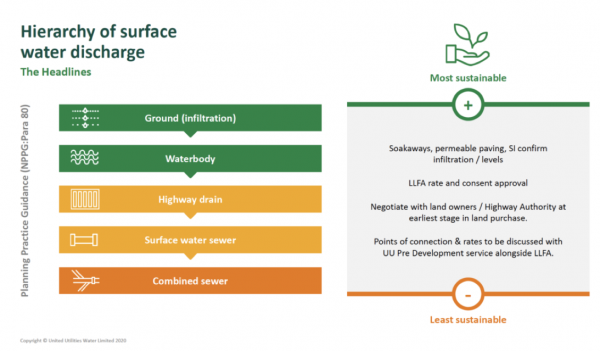
So what do you need to know to get your site to drain into the ground?
The first key point is design by collaboration is fundamental. We need to get the flood risk, drainage and site investigation (geology) professionals talking at the earliest opportunity.
Different councils will have different minimum standards:
- Does the site need over-winter groundwater monitoring and winter month (Oct – April) BRE365 testing before any planning permission can be provided?
- Can a desk-based assessment be provided as part of the planning application?
- Are you designing for foul drainage, surface water drainage or both?
The second key point is get a specialist – like Ground & Water – to review the site conceptually to see if soakaways are a viable option. This would need to include an overview of the likely groundwater/hydrogeological situation, to see if winter groundwater levels may impact soakaway .
The assessment above needs to be combined with an idea on the proposed development, to see where drainage features may go and with respect to the underlying geology:
- Are there any proposed development constraints e.g. basements?
- What geology is expected and what infiltration rate is expected?
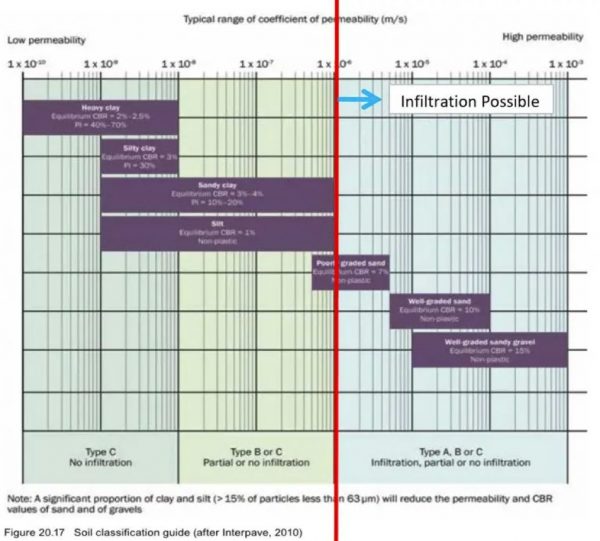
So the key points above have been addressed and now you need some site-based information on infiltration rates. What tests can you do and what tests do you need?
There are four tests and they have different uses and costs:
The BRE365 Soakaway or Infiltration Test
This is the go-to test if you want shallow conventional chambers, linked/ringed soakaways or trench soakaways. They should also be undertaken if you are considering installing porous paving.
The trial pit for these tests must be at least 1.0m long and 0.30m wide and the base level of the pit must be pursuant to the discharge level. Three repeat fillings are required for full compliance.
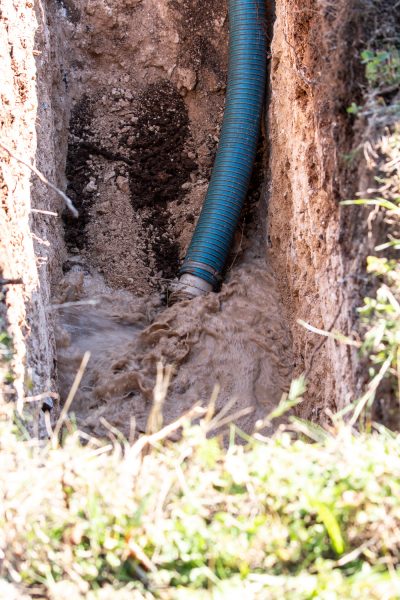 They are usually machine dug given their size and potential depth. We have dug tests up to 5m deep, when looking for good draining material. Sometimes it is also good to have the ability to test deeper, should the anticipated invert level not be in free draining material. It is often a positive to have an experienced ground engineer conducting the tests as they can judge the likely depth and location for good infiltration.
They are usually machine dug given their size and potential depth. We have dug tests up to 5m deep, when looking for good draining material. Sometimes it is also good to have the ability to test deeper, should the anticipated invert level not be in free draining material. It is often a positive to have an experienced ground engineer conducting the tests as they can judge the likely depth and location for good infiltration.
It may also be good to have a good water supply available, as BRE365 requires the inflow of water to be rapid, so the pit can be filled to its maximum effective depth in a short time. This means using a tanker to pump in the water and not a hosepipe, IBC or 250 gallon water bowser… sorry!
However, the expense of a tanker may well actually work in your favour, as the greater the volume of water you put in, the quicker the pressure builds and consequently the infiltration rate may be faster. This means smaller soaks, less attenuation crates etc. See below.
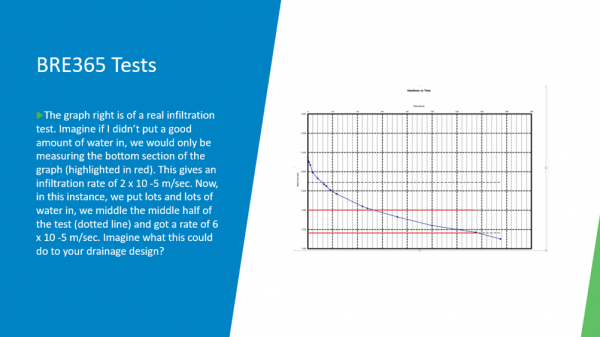
NHBC standard or BS5930 Falling Head Tests in boreholes
These should be used for indicative purposes only when designing shallow traditional soakaways. In reality, it’s their small diameter which results in a low surface area. The water can’t find fractures and they silt up easily. They can also be used for indicative design at an early stage, alongside your ground model.
These tests are vital when the permeable geology your looking for is deep – 4-5m plus. For example, where a 6.0m capping of clay with flints (generally pretty impermeable) overlies chalk.
In this situation a preliminary borehole is likely to be required, into the chalk, with a falling head or constant head test undertaken.
Constant Head Tests in boreholes
A constant head test is basically where the inflow of water into a borehole is maintained so that the head of water in the borehole is maintained. The rate of water inflow equals the rate of water infiltration into the ground. The constant head test is a slightly better test for boreholes and should be used where possible, although it isn’t always easy to vary the inflow of water into boreholes. A falling head can then be undertaken following a constant head test.
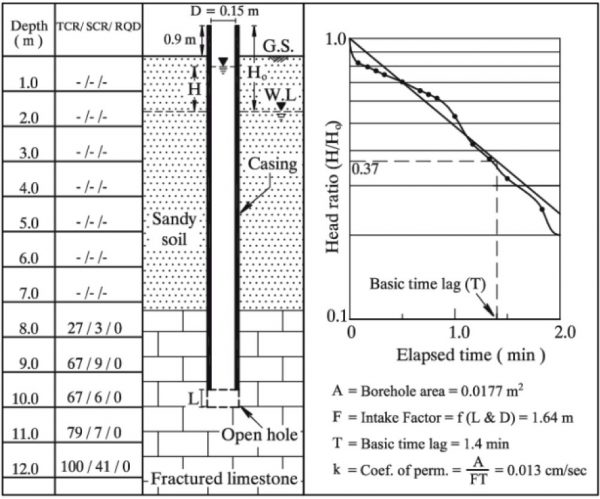
Pv (Percolation) Testing for Septic Tank/Drainage Field Assessment in accordance with EA guidance
These are the tests you do for drainage fields from treatment packages etc. They are used for the design of foul drainage fields. The pits required are smaller in diameter and generally shallower (300mm by 300mm) and generally <2m deep. The results of these tests fit directly into the design systems for sizing drainage fields, but can also be used as indicative/informative tests for porous paving (and possibly deeper soaks), subject to BRE365 tests at a later date. Learn more about Pv testing HERE
As with all tests, the results must be referenced back to the Conceptual Site Model developed at the desk-study stage; and also visual observations during logging.
Does the visual logging of the soils suggest conformity to that of the infiltration rate?
There are always laboratory tests which could be undertaken to aid clarification of the Conceptual Site Model and remove uncertainties, along with further site based infiltration tests.
Cost Comparisons
A good guide, written by others, is provided below:
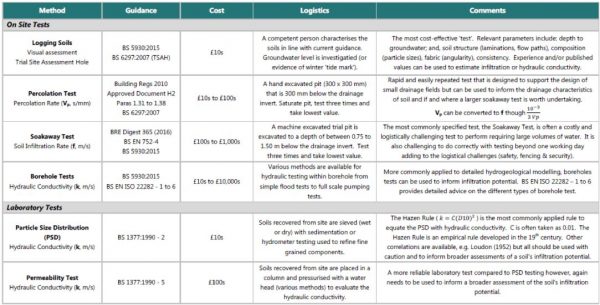
With flooding high on the regulators’ and the public’s agenda, ensuring the design of your drainage scheme meets or exceeds the standards laid down is vitally important. The underlying site geology plays a huge part so involving all the relevant professionals and engaging a site investigation specialist like Ground & Water at an early stage is key. We have a wealth of infiltration testing experience and detailed knowledge of the geology of London and the South of England, ensuring you get a cost effective site investigation that will give you the best chance of getting your project out of the ground.
